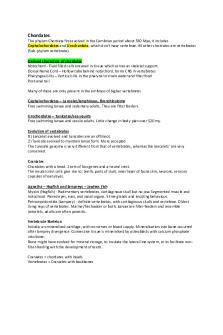Lab 12 - Lecture notes 12 PDF

| Title | Lab 12 - Lecture notes 12 |
|---|---|
| Course | Linear Electronics Lab |
| Institution | Old Dominion University |
| Pages | 5 |
| File Size | 370.6 KB |
| File Type | |
| Total Downloads | 92 |
| Total Views | 187 |
Summary
the subject is ANALOG-TO-DIGITAL AND DIGITAL-TO-ANALOG CONVERSION
with solutions...
Description
ASSIGNMENT 12 ANALOG-TO-DIGITAL AND DIGITAL-TO-ANALOG CONVERSION NAME:
Huy (last)
Nguyen (first)
GRADE: __________
Objectives: Utilize the analog-to-digital converter (ADC) model to convert an analog signal to a digital signal. Utilize the digital-to-analog converter (DAC) model to convert a digital signal to an analog signal. Combine the two units to form a data system and observe the conversion process. Pg. 1
This page with data added as requested should be Page 1 of the report.
Pg. 2
Begin the schematic diagram by placing the generic ADC model obtained from the Mixed parts bin on the screen. Next, place the VDAC model on the screen. It is recommended that you rotate it by 90o and then flip it over so that the 8 bits from the two modules are adjacent to each other. Perform the following connections: (a) Sinusoidal source with 10 V peak and a frequency of 1 kHz to Vin on the ADC (b) +10-V DC source connected between Vref+ and ground on the ADC (c) -10-V DC source connected between Vref- and ground on the ADC (d) Pulse voltage source between the start of conversion (SOC) terminal on the ADC and ground. Set voltage levels to 0 and 5 V. Set pulse width to 0.001 ms and period to 0.01 ms. (e) Direct connection between OE and end-of-conversion (EOC) terminals on the ADC (f) Each bit terminal of ADC connected to the corresponding bit terminal of DAC (g) +10-V DC source connected between Vref+ and ground on the DAC (h) -10-V DC source connected between Vref- and ground on the DAC (i) Connector pin to output of DAC. Save the circuit as Ckt12 in the Circuits sub-folder and create a Word schematic for Page 2.
Pg. 3
Temporarily disconnect the 4 least significant bits between the two units. Apply Transient Response to obtain input and output waveforms for Page 3. A time step of 10 ns is recommended for the run.
Pg. 4
Connect the 4 least significant bits so that the units can function with 8 bits. Repeat Step 3 to obtain waveforms for Page 4.
Pg. 5
SUMMARY AND CONCLUSIONS
Page 1 of 5
Schematic diagram
Page 2 of 5
Figure 1
Page 3 of 5
Figure 2
Page 4 of 5
Summary and Conclusion
In this lab, we have to utilize the analog-to-digital converter (ADC) model to convert an analog signal to a digital signal, utilize the digital-to-analog converter (DAC) model to convert a digital signal to an analog signal, and combine the two units to form a data system and observe the conversion process using multisim
Using the generic ADC model and the VDAC model obtained from the mixed parts bin on the screen. Both model using 8 bits.
A Sinusoidal source with 10 V peak and a frequency of 1 kHz to Vin on the ADC, +10-V DC source connected between Vref+ and ground on the ADC, -10-V DC source connected between Vref- and ground on the ADC. The Pulse voltage source between the start of conversion (SOC) terminal on the ADC and ground. Set voltage levels to 0 and 5 V. Set pulse width to 0.001 ms and period to 0.01 ms.
Connector pin to output of DAC. And temporarily disconnect the 4 least significant bits between the two units. Apply Transient Response to obtain input and output waveforms
Using Transient Response to obtain input and output waveforms in figure 1.
Reconnect the 4 pins and using Transient Response to obtain input and output waveforms in figure 2.
Overall, we demostrated the utilize the analog-to-digital converter (ADC) model to convert an analog signal to a digital signal, utilize the digital-to-analog converter (DAC) model to convert a digital signal to an analog signal, and combine the two units to form a data system and observe the conversion process using multisim
Page 5 of 5...
Similar Free PDFs

Lab 12 - Lecture notes 12
- 5 Pages

12 - Lecture notes 12
- 3 Pages

Chapter 12 - Lecture notes 12
- 4 Pages

LEC 12 - Lecture notes 12
- 3 Pages

(12) Mistake - Lecture notes 12
- 8 Pages

Chapter 12 - Lecture notes 12
- 9 Pages

Lecture notes, lecture 12
- 9 Pages

Lecture notes, lecture 12
- 7 Pages

Sachvui - Lecture notes 12
- 271 Pages

Mujadid - Lecture notes 12
- 1 Pages

Lecture 11 + 12 notes
- 16 Pages
Popular Institutions
- Tinajero National High School - Annex
- Politeknik Caltex Riau
- Yokohama City University
- SGT University
- University of Al-Qadisiyah
- Divine Word College of Vigan
- Techniek College Rotterdam
- Universidade de Santiago
- Universiti Teknologi MARA Cawangan Johor Kampus Pasir Gudang
- Poltekkes Kemenkes Yogyakarta
- Baguio City National High School
- Colegio san marcos
- preparatoria uno
- Centro de Bachillerato Tecnológico Industrial y de Servicios No. 107
- Dalian Maritime University
- Quang Trung Secondary School
- Colegio Tecnológico en Informática
- Corporación Regional de Educación Superior
- Grupo CEDVA
- Dar Al Uloom University
- Centro de Estudios Preuniversitarios de la Universidad Nacional de Ingeniería
- 上智大学
- Aakash International School, Nuna Majara
- San Felipe Neri Catholic School
- Kang Chiao International School - New Taipei City
- Misamis Occidental National High School
- Institución Educativa Escuela Normal Juan Ladrilleros
- Kolehiyo ng Pantukan
- Batanes State College
- Instituto Continental
- Sekolah Menengah Kejuruan Kesehatan Kaltara (Tarakan)
- Colegio de La Inmaculada Concepcion - Cebu




